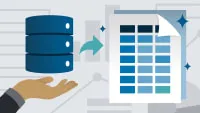
SAS 94 Cert Prep: Part 05 Analyzing and Reporting on Data 
This SAS Institute cert prep course provides the necessary skills to prepare for the SAS 9.4 certification exam. Learn how to use SAS to analyze and report on data, creating professional and engaging reports. ▼
ADVERTISEMENT
Course Feature
![]() Cost:
Cost:
Free Trial
![]() Provider:
Provider:
LinkedIn Learning
![]() Certificate:
Certificate:
No Information
![]() Language:
Language:
English
Course Overview
❗The content presented here is sourced directly from LinkedIn Learning platform. For comprehensive course details, including enrollment information, simply click on the 'Go to class' link on our website.
Updated in [March 06th, 2023]
This course, SAS 94 Cert Prep: Part 05 Analyzing and Reporting on Data, is designed to introduce students to methods for creating professional and engaging data analysis reports in SAS. It covers topics such as adding titles, footnotes, segments, labels, and macro variables to reports, as well as making frequency reports and summary statistics reports. Upon completion of this course, students will have a better understanding of how to create and present data analysis reports in SAS.
[Applications]
The application of this course can be seen in the ability to create professional and engaging data analysis reports in SAS. Learners can use the knowledge gained from this course to add titles, footnotes, segments, labels, and macro variables to reports, as well as create frequency reports and summary statistics reports.
[Career Paths]
1. Data Analyst: Data Analysts are responsible for collecting, organizing, and analyzing data to help inform business decisions. They use a variety of tools, such as SAS, to create reports and visualizations that help organizations understand their data. As data becomes increasingly important to businesses, the demand for Data Analysts is expected to grow.
2. Business Intelligence Analyst: Business Intelligence Analysts use data to help organizations make better decisions. They use SAS to create reports and visualizations that help organizations understand their data and make informed decisions. As businesses become more data-driven, the demand for Business Intelligence Analysts is expected to grow.
3. Data Scientist: Data Scientists use data to solve complex problems and develop new products and services. They use SAS to analyze data and create reports and visualizations that help organizations understand their data and make informed decisions. As businesses become more data-driven, the demand for Data Scientists is expected to grow.
4. Data Visualization Specialist: Data Visualization Specialists use data to create visualizations that help organizations understand their data and make informed decisions. They use SAS to create reports and visualizations that help organizations understand their data and make informed decisions. As businesses become more data-driven, the demand for Data Visualization Specialists is expected to grow.
[Education Paths]
1. Bachelor of Science in Data Science: This degree path focuses on the development of skills in data analysis, data mining, and machine learning. It also covers topics such as data visualization, predictive analytics, and big data. This degree is becoming increasingly popular as businesses and organizations rely more and more on data-driven decisions.
2. Master of Science in Business Analytics: This degree path focuses on the application of data analysis and predictive analytics to business decisions. It covers topics such as data mining, machine learning, and data visualization. This degree is becoming increasingly popular as businesses and organizations rely more and more on data-driven decisions.
3. Master of Science in Computer Science: This degree path focuses on the development of skills in computer programming, software engineering, and artificial intelligence. It also covers topics such as data structures, algorithms, and databases. This degree is becoming increasingly popular as businesses and organizations rely more and more on technology-driven decisions.
4. Master of Science in Information Systems: This degree path focuses on the development of skills in information systems, systems analysis, and database management. It also covers topics such as software engineering, web development, and network security. This degree is becoming increasingly popular as businesses and organizations rely more and more on technology-driven decisions.
Course Syllabus
Using titles and footnotes
Using macro variables and functions in titles and footnotes
Applying temporary labels to columns
Segmenting reports
Demo: Enhancing reports
Applying permanent labels to columns
Course Provider

Provider LinkedIn Learning's Stats at AZClass
Discussion and Reviews
0.0 (Based on 0 reviews)
Explore Similar Online Courses

Free Real Estate Investing Tutorial - Commercial Real Estate Investing for Beginners

Introduction to Portfolio Analysis in Python

Python for Informatics: Exploring Information

Social Network Analysis

Introduction to Systematic Review and Meta-Analysis

The Analytics Edge

DCO042 - Python For Informatics

Causal Diagrams: Draw Your Assumptions Before Your Conclusions

Whole genome sequencing of bacterial genomes - tools and applications

Applied Data Science: An Introduction

Big Data Integration and Processing

Data Science and Agile Systems for Product Management
 Related Categories
Related Categories
 Popular Providers
Popular Providers
Quiz
 Submitted Sucessfully
Submitted Sucessfully
1. Which of the following is a method for creating professional and engaging data analysis reports in SAS?
2. Which of the following is NOT a method for creating professional and engaging data analysis reports in SAS?
3. Which of the following is a way to make a frequency report in SAS?


Start your review of SAS 94 Cert Prep: Part 05 Analyzing and Reporting on Data